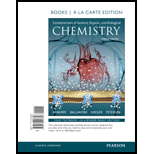
Concept explainers
Interpretation:
The substance which has higher vapour pressure from
Concept Introduction:
Vapour pressure of a liquid: Vapour pressure is defined as the pressure exerted by vapours of liquids when the equilibrium is established between liquid and its vapour.
The vapour pressure of a liquid is inversely proportional to the strength of the intermolecular forces present.
The stronger the intermolecular forces, closer will be the molecules in contact and thus higher will be the boiling point and melting point of the substance.
Three types of intermolecular forces:
- London dispersion
- Dipole-dipole
- Hydrogen bonding
Hydrogen bonding: It is an unusual strong intermolecular force occurs between a hydrogen atom and an electronegative atom like nitrogen, oxygen or fluorine.
It occurs in both water and ammonia
Want to see the full answer?
Check out a sample textbook solution
Chapter 8 Solutions
Modified Masteringchemistry With Pearson Etext -- Valuepack Access Card -- For Fundamentals Of General, Organic, And Biological Chemistry
- What is the vapor pressure of a liquid?arrow_forwardA sample of 8.00 mol of gas in a 10.00 L container is at 45.0 °C. What is the pressure (in atm) of the gas?arrow_forwardIf 4.00 L of ethyl alcohol at 18.0 ⁰C is exposed to a temperature of 25.0 ⁰C, what is the resulting volume? (Alcohol: β = 1100x10⁻⁶ / ⁰C) * a. 4.03 L b. 4.31 L c. 0.308 L d. 0.0308 Larrow_forward
- The vapour pressure of water at blood temperature is 47 Torr. What is the partial pressure of dry air in our lungs when the total pressure is 760 Torr?arrow_forward15.0 L of an ideal gas at 298 K and 3.36 atm are heated to 383 K with a new pressure of 6.05 atm. What is the new volume in liters?arrow_forwardA helium gas cylinder of the sort used to fill balloons has a volume of 0.180 m3 and a pressure of 150 X 105 Pa (150 atm) at 298 K (25 °C). How many moles of helium are in the tank? How many grams?arrow_forward
- define the equilibrium constant KP for the chemical equilibrium ofideal-gas mixtures?arrow_forwardWhat is the amount of these gases ( O2 , N2O , Air 4 bar , Air 7 bar ) that should the patient receive in hospital ?arrow_forwardCalculate the enthalpy of vaporization at the normal boiling point (760 mmHg) of the liquid(water, boiling point of 100 celsius).arrow_forward
- What is the volume (in mL) of ethanol in the bottle?arrow_forwardThe following equation shows the reaction of baking soda (NaHCO3) and hydrochloric acid (HCl). NaHCO3+HCl → CO2+H2O+NaCl If you have 3.0 grams of NaHCO3, how many moles of HCl are needed for a complete relation?arrow_forwardThe standard heat of combustion of liquid methyl cyclopentane, C6H12(l),C6H12(l), was measured to be −3937.7 kJ/mol.−3937.7 kJ/mol. What is Δ?̂ ∘f C6H12(l),ΔH^f C6H12(l)∘, the standard heat of formation of liquid methyl cyclopentane?arrow_forward
- Basic Clinical Lab Competencies for Respiratory C...NursingISBN:9781285244662Author:WhitePublisher:Cengage



